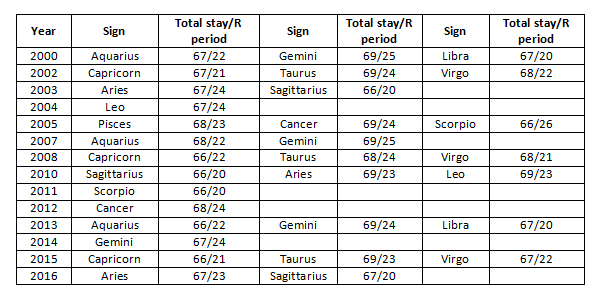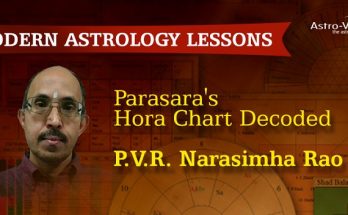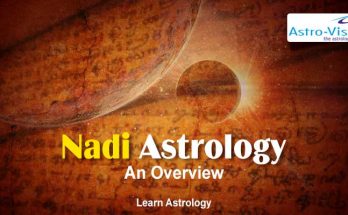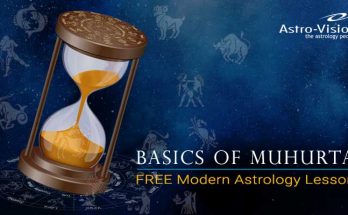Budhastambha refers to a comparatively longer stay of Mercury in a particular sign (about 66 to 69 days) as compared to its normal stay of a fortnight or so (14 to 18 days). Mercury’s such extended stay is sometimes spread over two signs – either equally but mostly unequally, but many times it covers only one sign which is termed in this paper as Budhastambha. Mercury is described as mild (Soumya), and so Budhastambha has not been referred to or analysed in astrological literature. But Mercury’s movements need to be studied in depth both in individual and mundane astrology for two reasons. Firstly, Mercury is the second fastest moving planet next to only to the Moon. Secondly, Mercury is an inferior planet, very close to the Sun, with a peculiar style of movement. Though Venus also is an inferior planet and shares some similarities with Mercury in respect of movements, Mercury’s pace and periodicity of the Stambha state make him the naughtiest planet (Mercury is the Karaka for small children who can be naughty and so, this adjective fits Mercury very well).
Budhastambha or Mercury’s Extended Stay in a Sign – Part I

Astrology is the science of time. Time moves forwards in the same direction unhindered and uninterrupted. Change is the essence of time. Time, though not directly making events happen, provides the basis for events and happenings. Time is defined on the basis of planetary positions and movements. So Mercury, having a faster pace, assumes a special place in astrology as a science of the study of time.
Jupiter and Saturn (and all other- superior planets except Mars) turn retrograde every year. The yearly planet-wise period of retrogression is more or less the same and is in increasing order in proportion to the distance from the earth. Mars, the nearest superior planet, moves at a pace slightly slower than the earth’s. So this state of Stambha called Kujastambha is unique.
Astronomical Angle
Combust When Direct
In the case of superior planets, when they enter combustion (astangata), they disappear from the western horizon (Paschimlopa). At the end of this phase, they reappear in the east, termed as rising in the east (Poorvadarshana/ udita). The superior planets have two different phases of movements both mutually exclusive – firstly, retrograde and secondly, combustion. But the case with the inferior planets is different. They have two types of combustion – one in normal direct motion and the other, when in retrograde motion. In the case of combustion associated with direct motion, Mercury will be in transit of a sign preceding that occupied by the Sun or at less longitude sign-wise than the Sun in the same sign. As a result, he starts coming closer and closer to the Sun. When Mercury is in a sign preceding the Sun-sign, he is seen in the eastern sky for a very short time just before sunrise (through telescope). When Mercury comes very close to the Sun, he moves into combustion and disappears from the eastern sky (Poorvalopa). Then he conjoins the Sun and thereafter overtakes the Sun and moving ahead of the Sun and covering the required distance moves out of combustion reappearing in the west when he is visible for a short period after sunset (Paschimdarshana). This disappearance and appearance of Mercury is exactly opposite in direction as compared to the superior planets. The daily pace of Mercury in combustion is about 2° or more. This period of combustion when in direct motion ranges from 18 to 46 days. The period is shorter (18-25 days) in April-May when the Sun is moving at a slower pace. The period of combustion increases to 40-45 days in October-December when the Sun is moving at a faster pace. During such periods, the daily motion of Mercury increases from 10° 45′ to 20° 10′ in just 20 days. This phase is of significance particularly in mundane astrology.
Table I: Sun – Mercury positions in Lunar Year 1938 (Ay: Chithrapaksha)
Combust When Retrograde
After appearing in the western sky for some time and after crossing the maximum distance of 28° from the Sun (nearly 28° for Mercury and 48° degrees for Venus) Mercury starts slowing down and then turns retrograde. Here since Mercury is either in a sign succeeding that occupied by the Sun or in the same sign with greater longitude, he is seen in the western sky after sunset. When Mercury approaches close to the Sun in retrogression, he becomes combust and disappears from the western sky (Paschimlopa). Once again there is the Sun-Mercury conjunction. After moving backwards, when the combust phase ends, Mercury starts reappearing in the eastern sky before sunrise (Poorvadarshana). After moving some distance in retrogression, Mercury becomes direct. This retrograde motion (including the phase of combustion) comes under Budhastambha (Table IV explains this with detailed movements of Mercury in the lunar year 1938).
Periods of Combustion and Retrogression
(i) In a lunar year (called Samvatsara hereafter), the total number of days are 354 or 384. Mercury is combust for a total period of 81 to 115 days in a lunar year while in direct motion. Mercury is retrograde for a period ranging from 66 to 79 days in a lunar year and out of this retrogression period, he is combust for a period of 38 to 51 days. The variations in these periods from year to year are much more in the case of Mercury as compared to other planets.
Table II: Mercury’s movements in a Year
(ii) Mercury follows a typical pattern in a Samvatsara. The pattern can be defined as: Direct movement – Combust phase – rise in West – Retrograde phase starts – Retrograde cum combust phase – Combust phase ends – Retrograde motion ends – starts Direct motion.Normally, this alternating combust and retrograde motion cycle recurs thrice in a lunar year i.e. 3 times combustion and 3 times retrogression in a Samvatsara. (Table I).
(iii) The Sun-Mercury conjunction occurs 6 to 7 times in a Samvatsara, alternating between combustion in direct motion and combustion in retrograde motion.
(iv) The conjunction recurs after a period ranging between 45 to 69 days. Two consecutive conjunctions in direct motion have a time gap of 104-130 days and two consecutive conjunctions in retrograde motion have a time gap of 104-126 days.
Table III: Dates of Sun – Mercury conjunctions
(v) Mercury turns retrograde in 88 to 102 days after assuming direct motion. Mercury’s retrograde motion lasts 20 to 25 days in a particular phase, including when in combustion which is of about 7 to 20 days.
(vi) After turning retrograde, Mercury becomes combust within 2 to 6 days. Mercury becomes direct within 2-7 days after the end of the combust phase.
(vii)The maximum pace in retrograde motion is 10° 22′.
(viii)Though the retrograde phase lasts for 20-25 days, the period of Mercury’s stay in a single sign ranges from 66-70 days. This stay is divided sometimes equally but many a time unequally in two signs.
(ix) These Stambha movements follow normally a pattern of 2-3 consecutive single sign Stambhas followed by 2-3 two-sign Stambhas. But this pattern is disturbed sometimes and after just only one single sign Stambha, two-three-two sign Stambhas occur.
(x) Normally 2-3 consecutive Stambhas take place in signs belonging to the same element.
Then the Stambha structure moves backwards element-wise i.e. after 3 Stambhas in airy signs, then Stambha structure shifts to earthy signs.
Table IV: Single – Sign mercury Stambhas
(xi) Normally single-sign Stambha is repeated in the same sign after a lapse of 6 to 7 years. (Over a period of 75 years, there were Gemini Stambhas in two consecutive Samvatsaras in 1935 and 1936 (Gregorian years 2013 and 2014) which is an exception.
(xii) In an analysis of 77lunar years (Samvatsara years 1861-1938), there were nearly 250 Budhastambhas. Out of these Stambhas, there were 132 single-sign Stambhas. Sign-wise distribution of these Stambhas showed a more or less uniform pattern with almost each sign Stambha recurring 10 to 12 times during this period except Gemini Stambha occurring 13 times in this span. A short extract of single-sign Stambhas over a period of 16 years (2000-2016) is presented in Table IV. In 16 years, there were 53 Stambhas including 31 single Stambhas. Sign-wise distribution also showed a regular pattern of 2-3 Stambhas per sign in this period with only exception of Pisces (only 1 Stambha) and Gemini (4 Stambhas)
Courtesy: Modern Astrology (Vilas G. Deo) (to be contd.)












One Comment on “Budhastambha or Mercury’s Extended Stay in a Sign – Part I”